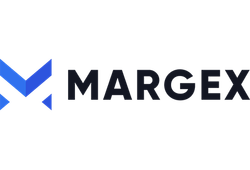
Curious about crypto derivatives trading but scared to try it out? It can definitely seem intimidating at first, but what if I told you there was a platform tailored for beginners? Well, buckle up because, in this Margex review, I'll introduce you to one!
Margex supports up to 100x leverage for perpetual futures contracts. The best part is that the platform provides quite a lot of learning material and even demo trading, so it’s a great place to start your derivatives trading journey.
Is Margex legit, though? What other features does it offer? Is it fit for advanced users? Let’s see.
Verdict at a glance: Margex provides a secure and user-friendly derivatives trading experience with up to 100x leverage and over 40 trading pairs. Notably, it does not require users to pass KYC. Besides derivatives trading, it offers convenient crypto purchasing, staking, an impressive referral program, copy trading, and more. However, expert traders may find some features lacking.
Stop overpaying - start transferring money with Ogvio. Join the waitlist & grab early Rewards NOW! 🎁
Pros
- Strong security measures
- Trading with up to 100x leverage
- Beginner-friendly interface and tools
- Buying crypto with a credit card
- No lock-up periods for staking
Cons
- Lack of advanced features for expert traders
Table of Contents
- 1. What is Margex?
- 2. Margex Review: PROS
- 2.1. Layered Security and Price Manipulation Prevention
- 2.2. Derivatives Trading with Up to 100x Leverage
- 2.3. Made for Beginners
- 2.4. Buying Crypto with a Credit Card? Check!
- 2.5. Staking, Bonuses, and Referral Program
- 3. Margex Review: CONS
- 3.1. Might Be Somewhat Limiting for Expert Traders
- 4. Margex Pricing
- 5. How to Use Margex?
- 5.1. How to Sign Up on Margex?
- 5.2. How to Trade on Margex?
- 6. Conclusions
What is Margex?
Before getting into a more in-depth Margex review, let’s get the basics down. What is Margex? Simply put, it’s a cryptocurrency exchange founded in 2019 that focuses on derivatives trading.
Besides derivatives trading, though, it also offers such features as copy trading, staking, price alerts, an attractive referral program, and more.

Do note that Margex is especially focused on beginners, seeking to provide them with hassle-free onboarding into derivatives trading. Though, it’s suitable for more advanced traders, too, mainly those who seek ease of use.
You can access the Margex exchange via the website and mobile browser or the mobile app, which is available on Android and iOS. However, you cannot access Margex in the US, the Republic of Seychelles, Bermuda, Cuba, Crimea, Sevastopol, Iran, Syria, North Korea, Sudan, and Afghanistan.
Now that you're acquainted with the platform and its target audience, let's dive further.
Margex Review: PROS
As I’ve explored the platform, I’ve noticed that there are quite a lot of things it does well, but there are also some drawbacks, so I plan to discuss both Margex pros and cons. That said, though, let’s kick things off in this Margex review by going over the pros.
Layered Security and Price Manipulation Prevention
If you’ve read other user Margex reviews, you might have noticed that it’s an unregulated crypto exchange based in Seychelles. That’s great news for all traders who are privacy-focused because it means that Margex does not require users to pass KYC.
Though, it also makes some question is Margex safe and legit. Well, I can say that being unregulated doesn't automatically make an exchange unsafe. While it lacks AML / KYC procedures, Margex's robust security infrastructure and fraud prevention tools are quite impressive, providing assurance for user safety.
There are three security layers:
- The user account security layer. It’s all about safeguarding your data and ensuring that no one else peeks into your account. It includes sensitive data and SSL encryption, Two-Factor Authentication (2FA), and even email alerts or some additional confirmations for any activity that happens in your account.
- The custodian security layer. It secures your assets. As Margex claims, all assets are stored in a multi-sig cold storage. Besides that, Margex has an access segregation system set in place to make sure no company employee goes bonkers and commits fraud.
- The trading infrastructure security layer. It essentially ensures a smooth and error-free usage of the platform and very fast order execution by employing some fancy-sounding measures, such as elastic server infrastructure, DDoS protection, and trading anti-denial service protection.
Asset and private data security protection aside, crypto derivatives trading overall is known to be quite risky[1]. Mostly because of the inherent volatility of crypto prices. Luckily, Margex has several price manipulation and fraud prevention measures set in place.
For example, it has a liquidity pooling system that ensures competitive entry and exit prices with minimal spreads. Also, it employs a price squeezing protection system to safeguard against unexpected twists and turns, executing orders at the anticipated price level.
Above all that, the Margex exchange refrains from listing assets prone to manipulation or low liquidity.

However, the price manipulation prevention feature that is praised the most in user Margex reviews is its MP Shield system. It’s like a smart shield that protects traders from tricks that dishonest traders might use to manipulate prices unfairly.
In essence, it uses artificial intelligence to spot any suspicious activities, such as fake trades or attempts to deceive other traders. When it detects these actions, it acts quickly to stop them.
So, what do you think? Is Margex safe? I’d say it would seem that it is.
Derivatives Trading with Up to 100x Leverage
Now, the star feature of the platform that must be discussed in any Margex review is futures trading.
More specifically, the Margex exchange provides users with perpetual futures contract trading settled in cryptocurrencies as margin. It allows both isolated and cross margin trading and offers the following order types – limit, market, and stop market.
What are crypto perpetual futures contracts? Well, simply put, they are like bets on the future price of cryptocurrencies. These contracts don't have an expiration date, so you can hold them for as long as you want, and you can use them to bet on whether the price will go up (long) or down (short).
Now, before in this Margex review, I’ve mentioned that the exchange supports up to 100x leverage (by the way, the minimum leverage is 5x). Leverage allows traders to open a larger position with a smaller amount of funds. So, they can potentially amplify both profits and losses[2].
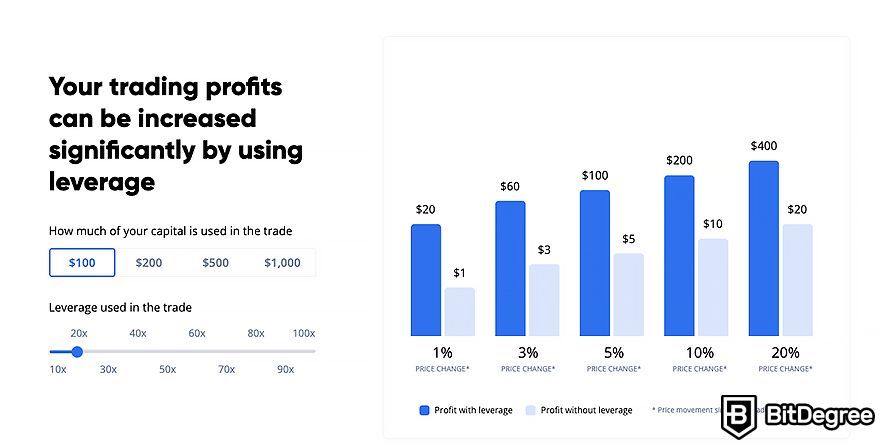
Speaking of opening positions, Margex offers crypto-USD (COIN-M) contracts with the most popular cryptocurrencies, including BTC, ETH, LTC, and others. Currently, there are over 40 trading pairs available.
However, in the near future, Margex also plans to introduce stablecoin-USD (USDT-M) pairs with USDT, USDC, DAI, and other stablecoins, as well as some Forex trading pairs with up to 500x leverage.
It’s also worth noting that the Margex exchange aggregates liquidity from over 12 liquidity providers, hence offering an extensive order book. This ensures that traders get prices that are both current and in line with market relevance. Besides that, this approach reduces price spread and the likelihood of slippage.

Okay, I’ve given you quite a lot of information about futures trading on Margex, but what do I think about it? Well, for one, it surely provides you with all the main tools a derivatives trading platform should.
Also, when it comes to leverage, 100x is kind of an “unwritten standard” in crypto futures trading. In fact, 100x leverage is quite a lot. Just keep in mind that leveraged trading is very risky, especially if you choose a high leverage. Just like you can get a big profit, you can lose a lot, too.
As for the trading pairs, it might not be the biggest number out there compared to some other similar platforms. However, Margex focuses on providing users only with assets that have high liquidity and are not subject to price manipulations. Plus, it does plan to support more pairs in the future.
Now, there’s one more thing I’ve noticed about Margex overall, and you’ll see that mentioned in many user Margex reviews, – it’s very beginner-friendly. However, let’s talk about that in more detail.
Made for Beginners
For starters, the whole platform navigation is made in an intuitive way. Especially the trading terminal, and I’ve seen my fair share of those.

On Margex, you won’t find any intricate and sometimes unnecessary charts, tools or information. The trading terminal is made up of three parts:
- Order-making interface;
- Trading pair chart, order book & last trades;
- Order and position management interface.
Of course, if you’re a complete newbie, it might still seem a bit scary. However, Margex has got even complete newbies covered because it provides various learning materials with clear explanations of how the platform (and trading in general) works. Not all similar platforms provide actually easy-to-understand explanations. Also, many user Margex reviews boast their customer support services.
Learning materials aside, Margex allows users to try out leveraged trading completely risk-free by using AirUSD tokens. They are demo tokens that will allow you to trade on Margex without putting actual money on the table. Of course, any profit you’ll gain from trading with AirUSD will also be considered demo.

To get AirUSD airdropped into your Margex wallet, you just need to fill in the Margex promo code - WLCM100. Once you do, you’ll get $100 worth of AirUSD and be able to start your simulated trading experience. Just note that AirUSD tokens will only be available for use for 14 days.
It’s a pretty unique way of simulated trading. In most cases, platforms provide separate simulated trading environments, not just limited-time demo tokens.
Now, moving further, it’s also worth noting that Margex allows copy trading, which is another great tool for beginners.
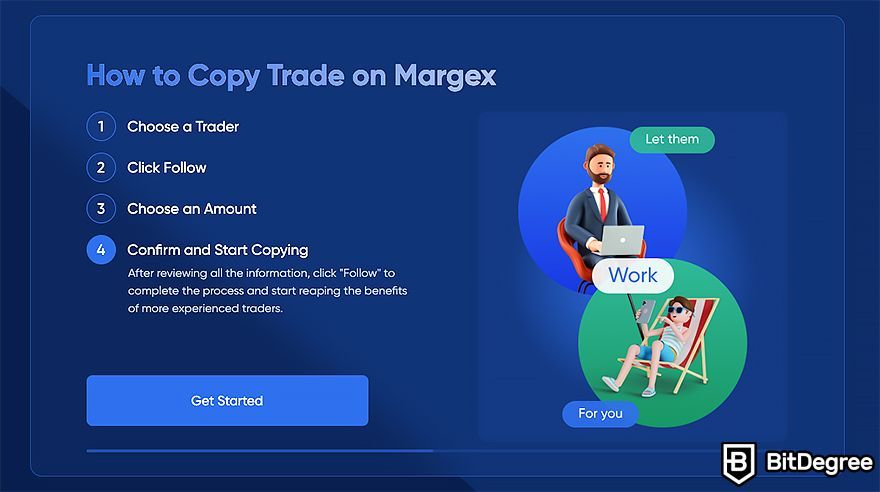
Copy trading lets traders either create their own strategies or invest in successful traders' strategies. A strategy on Margex is like a pool of funds with a specific trading plan. By putting in their funds, followers “copy” it, sharing profits with the owner of the strategy if it’s successful.
Thus, this benefits both traders and followers, helping them increase profits together. Traders get a Success fee from the generated profits, while followers get a certain percentage from the profits their added funds generated.
If they add anywhere between $1 and $100 worth of crypto, they’ll get 50%. However, if they add more than $100, they’ll get 100% of the profit.
That said, it’s also worth noting that Margex offers the option of setting price, volume, market cap, and ETH gas alerts. It allows you to take a breather from constant crypto market monitoring.
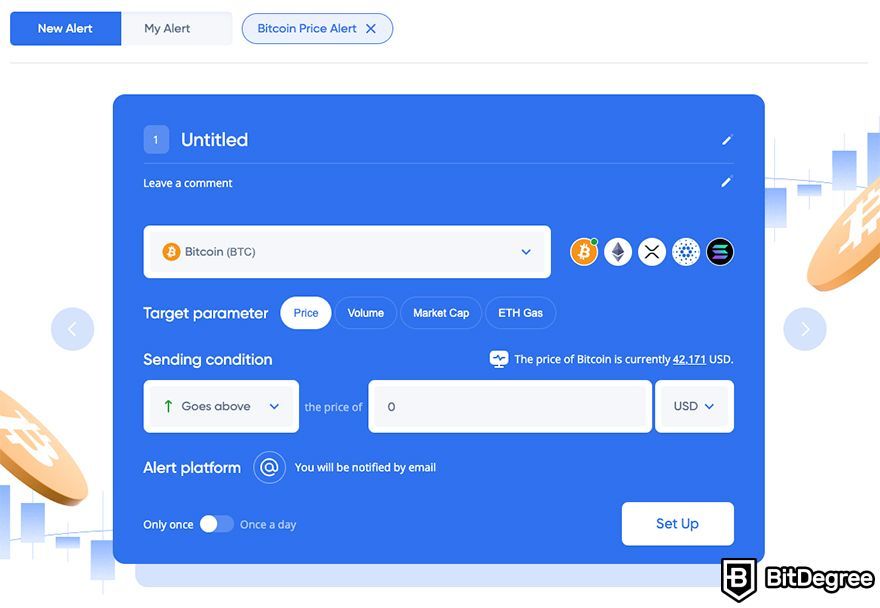
How do these alerts work? Well, you just set a target price / volume / market cap of an asset (or the price of ETH gas) and choose whether you want to be notified when the actual metric goes above or below it. Once it does, you’ll get notified via email.
Of course, all the features I’ve mentioned in this Margex exchange review will make any trader’s life easier, not just a beginner’s. Though, there’s one more feature that I think any crypto exchange should have, especially one that is made with beginners in mind – the option of buying crypto with fiat.
Buying Crypto with a Credit Card? Check!
Luckily, Margex provides users with an easy way to get crypto. You can buy it just like you would buy anything online – with your credit card. In fact, Margex supports a variety of payment methods, including the most popular ones – Mastercard, Visa, Google / Apple Pay, and others.
While the list of Margex supported coins for buying is not the widest, you’ll still easily get popular assets like BTC, ETH, LTC, USDT, and others. As for fiat support, USD is not the only currency you can use to buy crypto – you can also use AUD, CAD, GBP, and EUR.
Besides, it’s very easy to buy crypto on Margex. You just need to select the crypto you want to buy, the fiat you want to buy it with and choose the preferred payment method. Once you proceed with the purchase, you’ll have to complete the usual purchase verification steps you would take when buying anything else online.

However, if you already have some crypto, you can easily deposit it into your Margex wallet. Just note that the Margex minimum deposit amount is equal to $10 worth of the deposited cryptocurrency.
By the way, the exchange supports more assets for deposits than for purchasing. For example, you can deposit Binance Coin or Arbitrum into your wallet, but you wouldn’t be able to buy those.
Since we’re on the topic of deposits, you should also know that you can easily withdraw crypto from Margex into your wallet or another exchange, too. You won’t be able to make a direct bank transfer, however, but you can use third party providers to exchange crypto to fiat and then make a bank transfer.
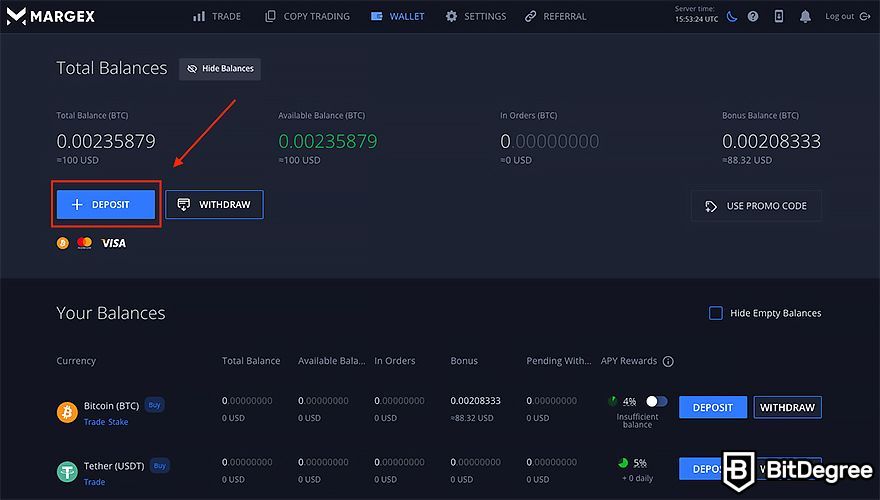
Keep in mind that the Margex withdrawal time will depend on when you make it because all withdrawals are processed between 12:00 - 14:00 UTC each day. If you place a withdrawal after 12:00 UTC, it will only be processed the next day.
What about Margex withdrawal fees? I’ve dedicated a separate section for all platform fees further in this Margex review, so we’ll talk about them later.
Now, you know that you can buy and trade crypto on Margex, but did you know that you can also earn it?
Staking, Bonuses, and Referral Program
There are three main ways to earn crypto on the Margex exchange – via the referral program, by staking, or through bonuses.
The referral program is the most talked about feature in many Margex reviews. Why? Because it provides quite impressive rewards. By sharing your Margex referral code with your friends, you can earn 40% of their trading commissions. The more referrals you have, the more you’ll be able to earn.
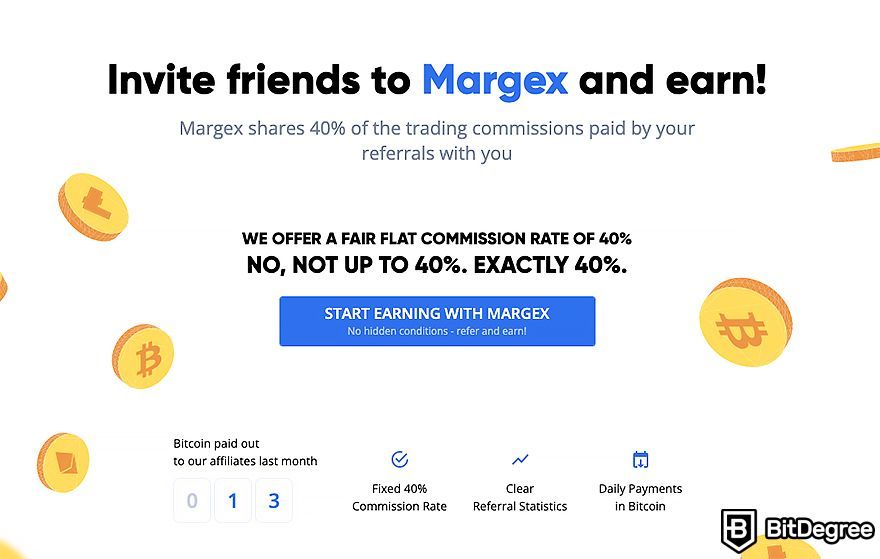
Moving further, staking is another way to earn on Margex. When you stake your assets, they are allocated to various CeFi and DeFi projects like liquidity mining, yield farming, and so on. Therefore, without selling or trading these assets, you are able to generate yield (or APY). Speaking of that, you can earn up to 5% APY, depending on the asset in question.
However, the best part about staking on Margex is that there are no lock-up periods. Usually, once you start staking your tokens on other exchanges, they get locked, and you can forget them for a set period of time. On Margex, however, you can unstake them anytime you want.

Staking rewards are calculated and added to your wallet balance every day. The amount you earn is based on the lowest balance you had since the last payout for that particular coin or token.
Also, note that Margex imposes staking pool limits, which refer to the maximum amount of liquidity available for new stakes within a pool. If the pool limit reaches 0% or if the pool liquidity is insufficient to accept new stakes, it will not be possible to stake that particular coin until the limit increases.
That’s pretty much it about staking. Now, what about bonuses?
You can earn bonuses that can be used to cover up to 50% of fees by joining various Margex marketing campaigns, competitions, events, and special promotions. However, you’ll notice in several Margex exchange reviews that there are a few bonuses that are always available (at least as of writing):
- Sign-up Bonus. A $50 worth of BTC bonus that is given to every new user;
- First Deposit Bonus. A bonus given for every first $100-worth deposit of an asset. If you deposit BTC, you get a $50 worth of BTC bonus, if you deposit ETH, you get a $50 worth of ETH bonus, and so on.
However, Margex bonuses are not added to your wallet as actual crypto assets. Instead, they are added as asset-specific bonuses and can then be used to reduce Margex fees. How to use Margex bonuses?
Once you close a position, up to 50% of that position's trading fees and funding will be covered using the bonus balance. However, don’t forget that each asset has its own balance and that the balance can only be used to cover fees when that specific asset is used as collateral.

Did you know?
All Crypto Exchanges may look similar to you but they're NOT all the same!
Margex Review: CONS
So, you already know what the platform does well. Now, let’s continue this Margex review by looking into what it could do better.
Might Be Somewhat Limiting for Expert Traders
Remember I’ve talked about the fact that Margex caters to beginners? Well, it does, and that's fantastic. The platform also positions itself as suitable for more advanced users, and I can't really argue with that either because some advanced users appreciate peace of mind.
However, when it comes to expert traders, Margex might have some limitations. Due to its focus on simplification, it may lack certain advanced features that experts find essential. Surprisingly, it doesn't even offer spot trading, which is the most basic feature on crypto exchanges (Margex is developing it as of writing, though).

The limited variety of supported trading pairs and Margex supported coins also doesn't make it very impressive for seasoned traders.
On the flip side, since Margex prioritizes beginner-friendliness, it provides a simplified version of a crypto exchange. Introducing numerous features for advanced users might compromise its ease of use, potentially turning into a “con” in beginner-friendly-focused Margex exchange reviews. After all, it's challenging to excel in all areas simultaneously.
Margex Pricing
Okay, we’ve covered all Margex pros and cons, which is almost all you need for deciding whether to use the platform or not. The last deciding factor that’s left to discuss in this Margex review is fees.
There are two types of Margex fees – trading fees and funding fees.
Trading fees are based on the maker / taker model. Market makers are charged a 0.019% fee for any trading pair, while market takers are charged a 0.06% fee.
Funding fees, on the other hand, are charges incurred by traders when they hold positions open beyond certain funding periods. These periods typically occur every 8 hours at specific times (00:00, 08:00, and 16:00 UTC).
The fees are applied based on the size of the open position and are calculated according to the prevailing funding rates for the selected trading pair. Funding rates are influenced by factors such as the ratio of long positions to short positions and market volatility.
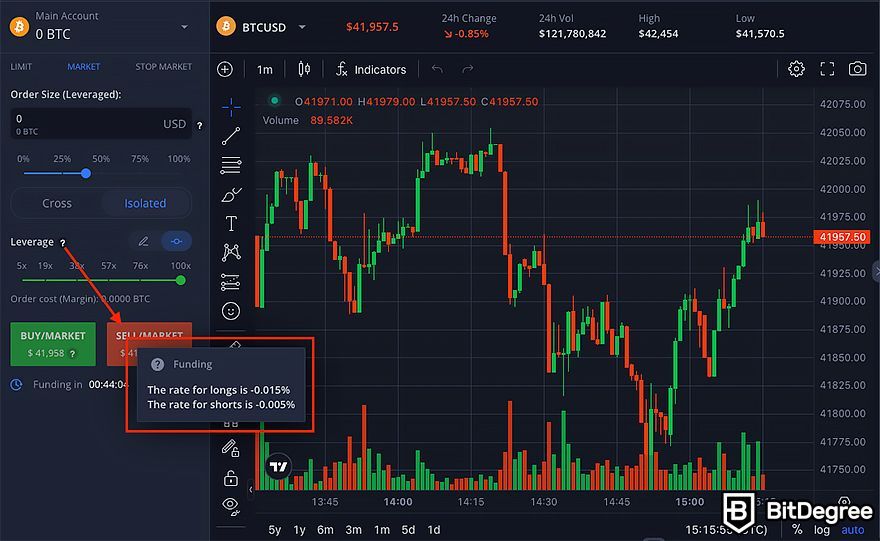
You can see the current funding fee for a specific trading pair by checking the funding timer displayed on the Trade page. Funding fees for long and short positions differ. However, if a position is closed before the next funding period begins, no funding fees are charged for that position.
Now, as for Margex withdrawal fees, there are none, just like there are no deposit fees. You’ll only need to pay network fees for withdrawing crypto, which is not charged by Margex (all actions on the blockchain incur network fees).
So, what is my verdict for Margex fees? Well, I’d say they really are competitive compared to the industry standard.
How to Use Margex?
You’ve read my Margex review up to this point and decided that you want to give a try to the platform? Great, but now, you might be wondering, how to trade on Margex. Let’s see.
How to Sign Up on Margex?
First off, before getting into trading, you need to sign up on the platform. Since there is no KYC required, the process is extremely simple and fast.
Step 1: On the Margex homepage, click on the “Start Trading” button.
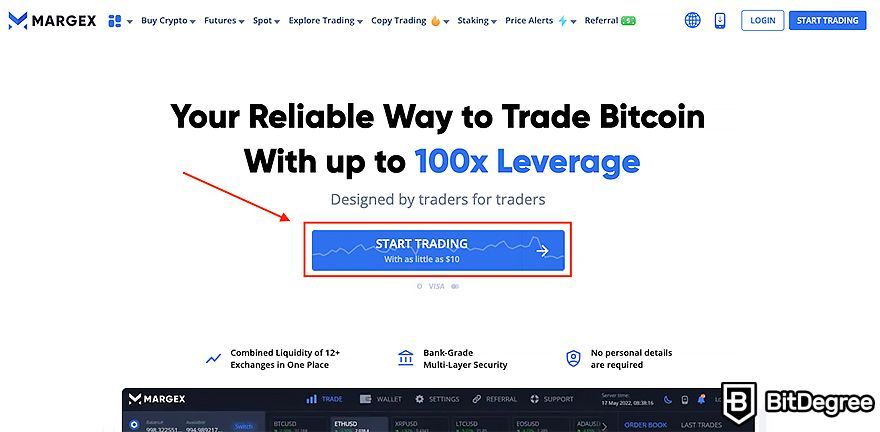
Step 2: You’ll be taken to the registration page, where you just have to fill in your email, come up with the password, and put in a referral code if you have one.
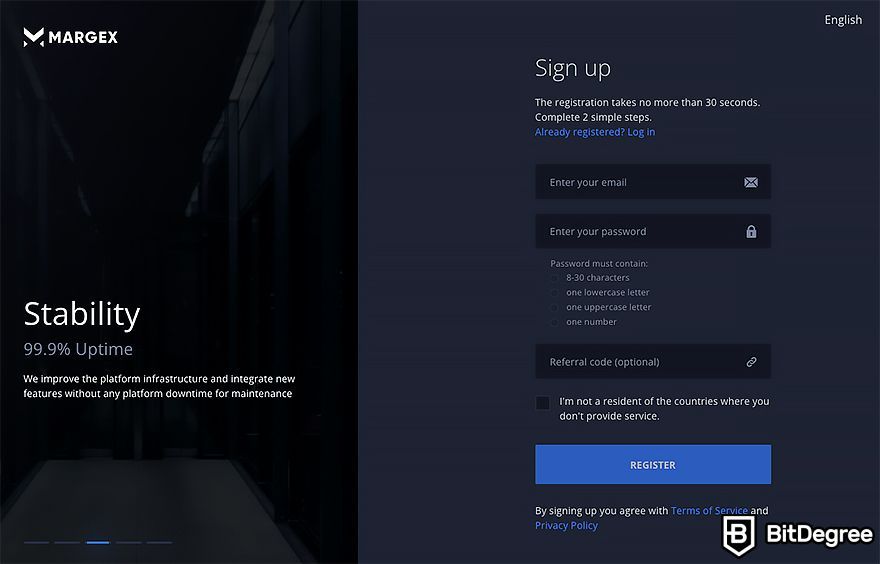
Step 3: The last thing you’ll need to do is verify your email address. Just enter the code you’ll find in your email.
Once that’s done, your account will be created, so you'll need to deposit crypto into your account (or buy it) before starting trading.
How to Trade on Margex?
Now, let’s get to the actual “how to trade on Margex” part.
Step 1: First, select the trading pair. Just click on the trading pair button and select whichever pair you want. You can also use the search bar.
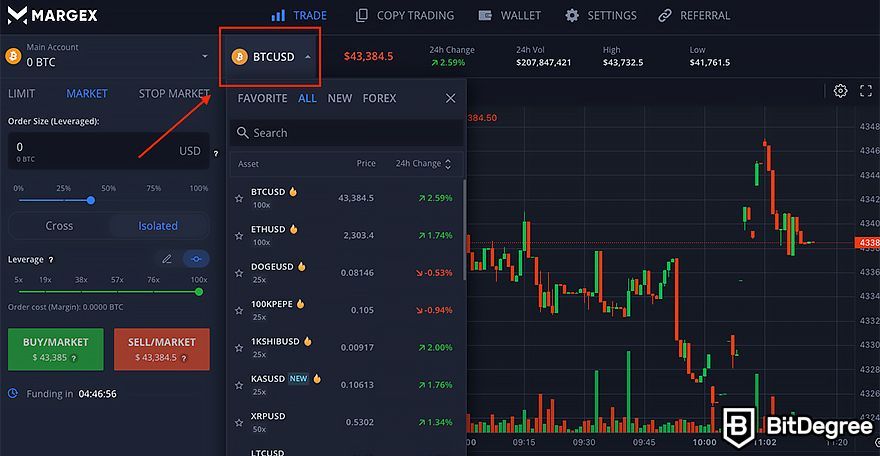
Step 2: Choose which type of order you want to make (limit, market, or stop market) and the total order size with leverage (in USD).

Step 3: Choose whether you want to use a cross or isolated margin and pick the leverage. It would be better to start small, though.

Step 4: Once all is set, place your buy or sell order. Overall, I suggest making the first order with demo funds and seeing how it goes.
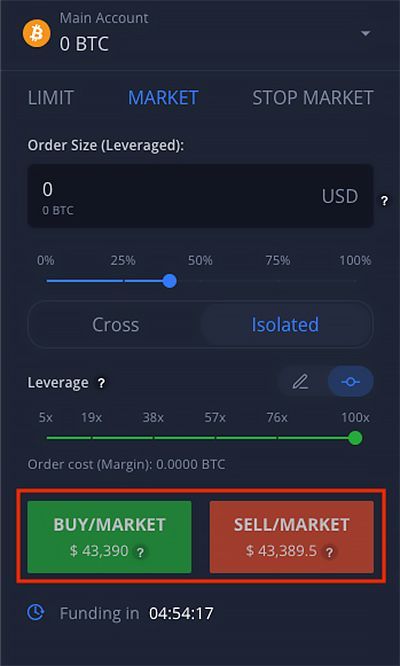
Besides, you can find tutorials that explain how to tade on Margex in more detail on their official website.

- Secure and reliable
- Accepts fiat currencies
- Lots of trading options
- Reputable exchange
- Accepts fiat currencies
- Offers various trading options

- Huge trading variety
- Regulation-compliant around the globe
- Fair trading fees
- Beginner-friendly
- A wide array of features
- Vast number of different crypto coins & tokens

- Beginner-friendly
- Secure
- Decent trading and withdrawal fees
- Crypto.com Visa Card
- Automated tools & bots
- Ecosystem synergy with CRO
Conclusions
Now that we've covered all the ins and outs, it's time to wrap up this Margex review. So, what's the bottom line?
Margex undoubtedly stands out as a user-friendly derivatives trading platform, offering beginners all the necessary tools and educational resources, along with some extra perks. However, it may fall short in catering to the needs of seasoned traders looking for more advanced features.
If you’re wondering is Margex safe, it does have robust security measures and comprehensive prevention tools against price manipulation set in place, so it seems to be safe.
Overall, my personal experience with Margex was hassle-free and enjoyable. Now, it's your turn to dive in and see it for yourself.
The content published on this website is not aimed to give any kind of financial, investment, trading, or any other form of advice. BitDegree.org does not endorse or suggest you to buy, sell or hold any kind of cryptocurrency. Before making financial investment decisions, do consult your financial advisor.
Scientific References
1. Y. Söylemez: 'Cryptocurrency Derivatives: The Case of Bitcoin';
2. Z. Wang, K. Qin, D. V. Minh, A. Gervais: 'Speculative Multipliers on DeFi: Quantifying On-Chain Leverage Risks'.


